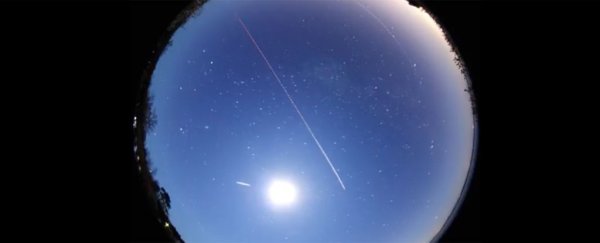For the first time, scientists have predicted the activity of a comet based on observations of its trailing meteoroids – and in doing so have solved the mystery of how a meteor shower called the Phoenicids was barely seen from Earth for almost 60 years.
Unlike some of the particularly famous annual meteor showers enjoyed by stargazers across the globe, the Phoenicids were discovered in a spectacular meteor storm that rained down just once in 1956 – and then for several decades, the fireworks virtually disappeared.
Until 2014, that is, when a team of researchers from the Graduate University for Advanced Studies (SOKENDAI) in Japan – including one of the veterans behind the 1956 observation – again witnessed the Phoenicids light show, thanks to astronomical data going as far back as the 1800s.
The Phoenicids meteor shower – named after the Phoenix constellation – was first seen around the world on 5 December 1956, including observations made by a team on the first Japanese Antarctic Research Expedition in the Indian Ocean.
The shower, which produced a storm of hundreds of meteorites, treated onlookers to exploding fireballs and burning fragments tearing across the sky in a range of colours from reddish to yellow.

But this intense display was never seen again in the years that followed, prompting scientists to wonder just where exactly the Phoenicids had come from and disappeared to.
Now, it looks like we might have an answer, courtesy of another mysterious celestial body, called the Comet Blanpain.
This comet (aka 289P/Blanpain) was first discovered way back in 1819 before it too seemingly vanished from human eyes – until a discovery almost two centuries later showed what might have happened to this lost comet.
In 2003, a newly discovered asteroid called 2003 WY25 was calculated to be moving along the same orbit as Comet Blanpain, and subsequent analysis revealed that the asteroid was effectively the ghost of the long lost comet – albeit only a shadow of its former self, having shed most of its gas and dust.
Comet Blanpain – now more accurately categorised as an asteroid – was hypothesised to be the parent body behind the Phoenicids meteor shower, with fragments of its dust trail being responsible for the Phoenicids light show in 1956, as particles burnt up when hitting Earth's atmosphere.
To test the hypothesis, two teams from SOKENDAI made new calculations of where and when this meteoric phenomenon would again be visible, predicting a light show on 1 December 2014.
Setting up observations from North Carolina and the Spanish island of La Palma in the Canary Islands, the researchers' prediction turned out to be accurate, within about one hour – not bad, given their limited dataset for the night-time viewing went back some 200 years or so.
One of those in attendance was 91-year-old Junji Nakamura, who had first observed the Phoenicids nearly six decades ago when sailing on the Indian Ocean.
"That is what I remember," he was quoted as saying in The Japan Times, in reference to the slow shooting of the meteors.
"The calculation of the appearance was correct."
Further study of the 2014 meteor shower analysed the trajectory of each meteor trail, and found that of the 138 meteors observed from the North Carolina site (the La Palma results have yet to be published), 29 were identified as Phoenicids.
That's a good number short of the epic Phoenicids meteor storm witnessed back in 1956 – which peaked at 300 trails per hour – but the researchers can explain why these shooting stars are in decline.
The reasoning is to do with Comet Blanpain, which was on its last legs – in terms of its volume of gas and dust – the last time it approached Earth.
"This indicates that the parent body of the Phoenicids… was still active as a comet in the early 20th century and provided meteoroids," the team writes, "although its activity level was significantly weaker than that at the beginning of the 19th century."
So what we're seeing here is the last hurrah of a soon-to-be ghost comet as it arcs through the void of space – but at least we caught one of the final shows.
The findings are reported in Publications of the Astronomical Society of Japan.
